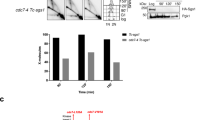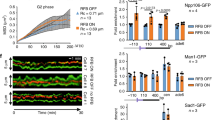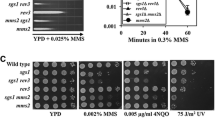Abstract
DNA polymerases sometimes stall during DNA replication at sites where DNA is damaged, or upon encounter with proteins or secondary structures of DNA. When that happens, the polymerase clamp PCNA can become modified with a single ubiquitin moiety at lysine 164, opening DNA Damage Tolerance (DDT) mechanisms that either repair or bypass the lesions. An alternative repair mechanism is the salvage recombination (SR) pathway, which copies information from the sister chromatid. SUMOylation of PCNA at the same lysine, or at lysine 127, can recruit the Srs2 helicase, which negatively controls SR. Recently, we have dissected the relationship between SR and the DDT pathways, and showed that overexpression of either the PCNA unloader Elg1, or the Rad52 homologous recombination protein, can bypass the repression by Srs2. Our results shed light on the interactions between different DNA damage repair/bypass proteins, and underscore the importance of PCNA modifications in organizing the complex task of dealing with DNA damage during replication of the genetic material.

Similar content being viewed by others
References
Acharya N, Manohar K, Peroumal D, Khandagale P, Patel SK, Sahu SR, Kumari P (2019) Multifaceted activities of DNA polymerase eta: beyond translesion DNA synthesis. Curr Genet 65:649–656. https://doi.org/10.1007/s00294-018-0918-5
Adames NR, Gallegos JE, Peccoud J (2019) Yeast genetic interaction screens in the age of CRISPR/Cas. Curr Genet 65:307–327. https://doi.org/10.1007/s00294-018-0887-8
Arbel M, Bronstein A, Sau S, Liefshitz B, Kupiec M (2020) Access to PCNA by Srs2 and Elg1 controls the choice between alternative repair pathways in yeast. mBio. https://doi.org/10.1128/mBio.00705-20
Bai Y, Symington LS (1996) A Rad52 homolog is required for RAD51-independent mitotic recombination in Saccharomyces cerevisiae. Genes Dev 10:2025–2037
Ballew O, Lacefield S (2019) The DNA damage checkpoint and the spindle position checkpoint: guardians of meiotic commitment. Curr Genet. https://doi.org/10.1007/s00294-019-00981-z
Bebenek A, Ziuzia-Graczyk I (2018) Fidelity of DNA replication-a matter of proofreading. Curr Genet 64:985–996. https://doi.org/10.1007/s00294-018-0820-1
Berto G, Ferreira-Cerca S, De Wulf P (2019) The Rio1 protein kinases/ATPases: conserved regulators of growth, division, and genomic stability. Curr Genet 65:457–466. https://doi.org/10.1007/s00294-018-0912-y
Bordelet H, Dubrana K (2019) Keep moving and stay in a good shape to find your homologous recombination partner. Curr Genet 65:29–39. https://doi.org/10.1007/s00294-018-0873-1
Branzei D, Szakal B (2016) DNA damage tolerance by recombination: Molecular pathways and DNA structures. DNA Repair (Amst) 44:68–75. https://doi.org/10.1016/j.dnarep.2016.05.008
Branzei D, Vanoli F, Foiani M (2008) SUMOylation regulates Rad18-mediated template switch. Nature 456:915–920
Bronstein A, Bramson S, Shemesh K, Liefshitz B, Kupiec M (2018a) Tight regulation of srs2 helicase activity is crucial for proper functioning of DNA repair mechanisms. G3 8:1615–1626. https://doi.org/10.1534/g3.118.200181
Bronstein A, Gershon L, Grinberg G, Alonso-Perez E, Kupiec M (2018b) The main role of Srs2 in DNA repair depends on its helicase activity, rather than on its interactions with PCNA or Rad51. mBio 9:e0119218. https://doi.org/10.1128/mBio.01192-18
Chu WK, Hickson ID (2009) RecQ helicases: multifunctional genome caretakers. Nat Rev Cancer 9:644–654. https://doi.org/10.1038/nrc2682
Corcoles-Saez I, Dong K, Cha RS (2019) Versatility of the Mec1(ATM/ATR) signaling network in mediating resistance to replication, genotoxic, and proteotoxic stresses. Curr Genet 65:657–661. https://doi.org/10.1007/s00294-018-0920-y
De Tullio L, Kaniecki K, Kwon Y, Crickard JB, Sung P, Greene EC (2017) Yeast Srs2 helicase promotes redistribution of single-stranded DNA-bound RPA and Rad52 in homologous recombination regulation. Cell Rep 21:570–577. https://doi.org/10.1016/j.celrep.2017.09.073
Fan Q, Xu X, Zhao X, Wang Q, Xiao W, Guo Y, Fu YV (2018) Rad5 coordinates translesion DNA synthesis pathway by recognizing specific DNA structures in Saccharomyces cerevisiae. Curr Genet 64:889–899. https://doi.org/10.1007/s00294-018-0807-y
Garbacz MA, Lujan SA, Kunkel TA (2020) Opportunities for new studies of nuclear DNA replication enzymology in budding yeast. Curr Genet 66:299–302. https://doi.org/10.1007/s00294-019-01023-4
Garcia-Rodriguez N, Morawska M, Wong RP, Daigaku Y, Ulrich HD (2018) Spatial separation between replisome- and template-induced replication stress signaling. EMBO J. https://doi.org/10.15252/embj.201798369
Gazy I, Liefshitz B, Bronstein A, Parnas O, Atias N, Sharan R, Kupiec M (2013) A genetic screen for high copy number suppressors of the synthetic lethality between elg1Delta and srs2Delta in yeast. G3 3:917–926. https://doi.org/10.1534/g3.113.005561
Gkouskou K, Fragiadakis GS, Voutsina A, Alexandraki D (2019) Distinct associations of the Saccharomyces cerevisiae Rad9 protein link Mac1-regulated transcription to DNA repair. Curr Genet. https://doi.org/10.1007/s00294-019-01047-w
Hoege C, Pfander B, Moldovan GL, Pyrowolakis G, Jentsch S (2002) RAD6-dependent DNA repair is linked to modification of PCNA by ubiquitin and SUMO. Nature 419:135–141. https://doi.org/10.1038/nature00991
Jablonovich Z, Liefshitz B, Steinlauf R, Kupiec M (1999) Characterization of the role played by the RAD59 gene of Saccharomyces cerevisiae in ectopic recombination. Curr Genet 36:13–20
Karras GI, Jentsch S (2010) The RAD6 DNA damage tolerance pathway operates uncoupled from the replication fork and is functional beyond S phase. Cell 141:255–267. https://doi.org/10.1016/j.cell.2010.02.028
Krejci L, Van Komen S, Li Y, Villemain J, Reddy MS, Klein H, Ellenberger T, Sung P (2003) DNA helicase Srs2 disrupts the Rad51 presynaptic filament. Nature 423:305–309. https://doi.org/10.1038/nature01577
Kubota T, Nishimura K, Kanemaki MT, Donaldson AD (2013) The Elg1 replication factor C-like complex functions in PCNA unloading during DNA replication. Mol Cell 50:273–280. https://doi.org/10.1016/j.molcel.2013.02.012
Li S, Dong Z, Yang S, Feng J, Li Q (2019) Chaperoning RPA during DNA metabolism. Curr Genet. https://doi.org/10.1007/s00294-019-00945-3
Liberi G, Chiolo I, Pellicioli A, Lopes M, Plevani P, Muzi-Falconi M, Foiani M (2000) Srs2 DNA helicase is involved in checkpoint response and its regulation requires a functional Mec1-dependent pathway and Cdk1 activity. Embo J 19:5027–5038. https://doi.org/10.1093/emboj/19.18.5027
Ma M, Rodriguez A, Sugimoto K (2020) Activation of ATR-related protein kinase upon DNA damage recognition. Curr Genet 66:327–333. https://doi.org/10.1007/s00294-019-01039-w
Marsella A, Cassani C, Casari E, Tisi R, Longhese MP (2019) Structure-function relationships of the Mre11 protein in the control of DNA end bridging and processing. Curr Genet 65:11–16. https://doi.org/10.1007/s00294-018-0861-5
Moriel-Carretero M, Pasero P, Pardo B (2019) DDR Inc., one business, two associates. Curr Genet 65:445–451. https://doi.org/10.1007/s00294-018-0908-7
Owiti N, Stokdyk K, Kim N (2019) The etiology of uracil residues in the Saccharomyces cerevisiae genomic DNA. Curr Genet 65:393–399. https://doi.org/10.1007/s00294-018-0895-8
Parnas O, Zipin-Roitman A, Pfander B, Liefshitz B, Mazor Y, Ben-Aroya S, Jentsch S, Kupiec M (2010) Elg1, an alternative subunit of the RFC clamp loader, preferentially interacts with SUMOylated PCNA. EMBO J 29:2611–2622. https://doi.org/10.1038/emboj.2010.128
Piazza A, Heyer WD (2019) Moving forward one step back at a time: reversibility during homologous recombination. Curr Genet 65:1333–1340. https://doi.org/10.1007/s00294-019-00995-7
Saponaro M, Callahan D, Zheng X, Krejci L, Haber JE, Klein HL, Liberi G (2010) Cdk1 targets Srs2 to complete synthesis-dependent strand annealing and to promote recombinational repair. PLoS Genet 6:e1000858. https://doi.org/10.1371/journal.pgen.1000858
Sau S, Kupiec M (2020) A role for the yeast PCNA unloader Elg1 in eliciting the DNA damage checkpoint. Curr Genet 66:79–84. https://doi.org/10.1007/s00294-019-01020-7
Shemesh K, Sebesta M, Pacesa M, Sau S, Bronstein A, Parnas O, Liefshitz B, Venclovas C, Krejci L, Kupiec M (2017) A structure-function analysis of the yeast Elg1 protein reveals the importance of PCNA unloading in genome stability maintenance. Nucleic Acids Res 45:3189–3203. https://doi.org/10.1093/nar/gkw1348
Shkedy D, Singh N, Shemesh K, Amir A, Geiger T, Liefshitz B, Harari Y, Kupiec M (2015) Regulation of Elg1 activity by phosphorylation. Cell Cycle 14:3689–3697. https://doi.org/10.1080/15384101.2015.1068475
Singh B, Wu PJ (2019) Linking the organization of DNA replication with genome maintenance. Curr Genet 65:677–683. https://doi.org/10.1007/s00294-018-0923-8
Stelter P, Ulrich HD (2003) Control of spontaneous and damage-induced mutagenesis by SUMO and ubiquitin conjugation. Nature 425:188–191. https://doi.org/10.1038/nature01965
Szwajczak E, Fijalkowska IJ, Suski C (2018) The importance of an interaction network for proper DNA polymerase zeta heterotetramer activity. Curr Genet 64:575–580. https://doi.org/10.1007/s00294-017-0789-1
Tutaj H, Pogoda E, Tomala K, Korona R (2019) Gene overexpression screen for chromosome instability in yeast primarily identifies cell cycle progression genes. Curr Genet 65:483–492. https://doi.org/10.1007/s00294-018-0885-x
Urulangodi M, Sebesta M, Menolfi D, Szakal B, Sollier J, Sisakova A, Krejci L, Branzei D (2015) Local regulation of the Srs2 helicase by the SUMO-like domain protein Esc2 promotes recombination at sites of stalled replication. Genes Dev 29:2067–2080. https://doi.org/10.1101/gad.265629.115
Vaze MB, Pellicioli A, Lee SE, Ira G, Liberi G, Arbel-Eden A, Foiani M, Haber JE (2002) Recovery from checkpoint-mediated arrest after repair of a double-strand break requires Srs2 helicase. Mol Cell 10:373–385. https://doi.org/10.1016/s1097-2765(02)00593-2
Veaute X, Jeusset J, Soustelle C, Kowalczykowski SC, Le Cam E, Fabre F (2003) The Srs2 helicase prevents recombination by disrupting Rad51 nucleoprotein filaments. Nature 423:309–312. https://doi.org/10.1038/nature01585
Zimmer C, Fabre E (2019) Chromatin mobility upon DNA damage: state of the art and remaining questions. Curr Genet 65:1–9. https://doi.org/10.1007/s00294-018-0852-6
Acknowledgements
We thank past and present members of the Kupiec lab for support, ideas and support. This work was supported by grants from the Israel Science Foundation, the Minerva Center and the Israel Cancer Research Fund to MK.
Author information
Authors and Affiliations
Corresponding author
Additional information
Communicated by Judith Berman.
Publisher's Note
Springer Nature remains neutral with regard to jurisdictional claims in published maps and institutional affiliations.
Rights and permissions
About this article
Cite this article
Arbel, M., Liefshitz, B. & Kupiec, M. How yeast cells deal with stalled replication forks. Curr Genet 66, 911–915 (2020). https://doi.org/10.1007/s00294-020-01082-y
Received:
Revised:
Accepted:
Published:
Issue Date:
DOI: https://doi.org/10.1007/s00294-020-01082-y




